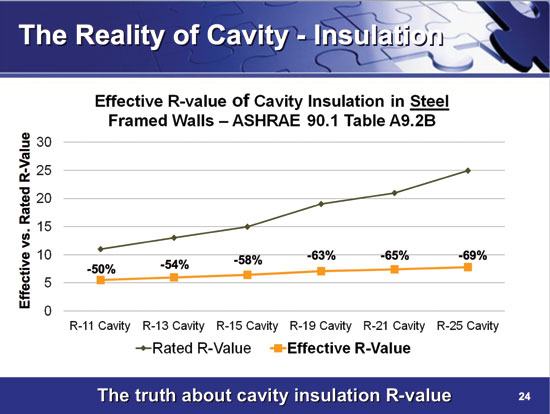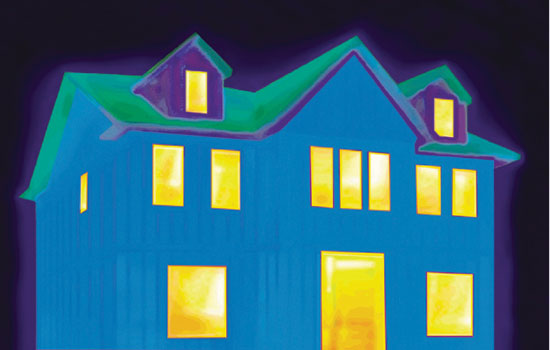EIFS - Performance Beyond Code Compliance
Continuous insulation. The energy code and adopted standards have always established minimum insulation and thermal performance levels for exterior walls. The latest versions recognize the limitations of construction and in many cases require not only common wall cavities in stud wall construction to be insulated, but for continuous layers of uninterrupted insulation to be provided as well. The reason behind the requirement comes from extensive study and analysis by ASHRAE and others on the notable inefficiencies of traditional cavity wall insulation, particularly using metal studs. The issue is the numerous interruptions of the insulation by the framing members or studs that act as direct “thermal bridges” between the inside and outside. Many architects and engineers understand that the insulation is compromised in this situation and therefore decide to simply increase the amount of insulation to raise the R-value between the studs. While this sounds logical, ASHRAE studies have shown it doesn't work. The reality is that using a minimal R-11 cavity insulation between steel studs has been tested to show that the effective R-value of the wall to be about R-5.5 or 50 percent less than the stated insulation R-value. Increasing the insulation to R-19 doesn't perform much better since its effective R-value tested out at just over R-7 or 63 percent less than its stated value. Even bumping the insulation up to R-25 only creates a modest effective R-value of R-7.75 or 69 percent less than the stated value.
 |
Effective R-values of cavity wall insulation with metal studs compared to the stated R-value of the insulation. Image courtesy of Dryvit Systems, Inc. |
Recognizing this significant practical problem, the IECC and ASHRAE 90.1 allow for two means to demonstrate thermal performance. The first is with prescriptive R-values for walls based on the building's location in one of eight climate zones throughout the U.S. Those prescriptive requirements now include many instances where a minimum amount of continuous insulation (ci) must be used in addition to insulation provided between the studs. The ci reduces the thermal bridging effect of those studs and allows the true effective R-value of the wall to be higher than without it. The R-values listed in the code apply only to the insulation itself and assume cavity stud wall construction to allow for an adequate overall energy performance of the wall.
 |
The International Energy Conservation Code and ASHRAE 90.1 now include prescriptive requirements for R-values of both cavity wall insulation and continuous insulation. Image courtesy of Dryvit Systems, Inc. |
The second way to demonstrate thermal performance is to show a calculated U-factor for the total wall assembly, not just the insulation. ASHRAE 90.1 includes Appendix A which lists various common wall assemblies and their tested U-factors. If the wall assembly being used in a particular project is not listed, then it will need to be custom calculated. While that is relatively easy for wood frame construction, it is more complicated for metal stud construction or other alternatives. Hence, it is likely that some sophisticated software will be needed such as THERM which is publicly available from Lawrence Berkeley National Laboratory (LBNL). Either way, code compliance is demonstrated by comparing the maximum allowable U-factor in the code or 90.1 to the identified U-factor for the wall in the subject building. In many cases, the U-factor analysis will likely be more stringent than basing compliance on the R-value tables in the code. However, for walls that are completely insulated with ci, the difference will likely be less significant since the full R-value of the ci is realized in the assembly and not compromised by thermal bridging.
 |
 |
Thermal imaging shows the notable difference in heat loss between an exterior wall that relies on stud walls with cavity insulation (top) and a wall that uses continuous insulation (bottom). Photos courtesy of Dryvit Systems, Inc. and The Dow Chemical Company |









